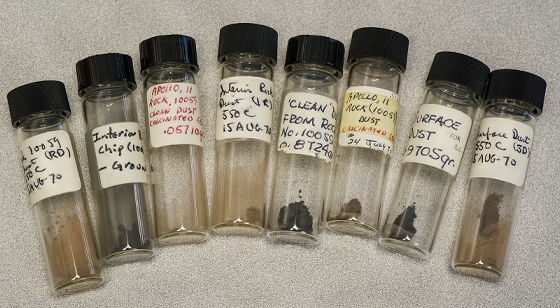"Moon dust" that Apollo 11 brought back from the moon is discovered for the first time in 40 years

Collected by Apollo 11 which succeeded on lunar landing by the first mankind in history, "Moon dust"The glass container containing this has been missing for nearly 40 years, but it seems that it was finally found last month.
Lost Apollo 11 Moon Dust Found in Storage | Space.com
http://www.space.com/21050-apollo-11-moon-dust-found.html
Glass containers with moon dust were discovered by Karen Nelson, an official document keeper of Lawrence Berkeley National Laboratory, California earlier this month. It seems that it was kept in a cabinet in California's laboratory warehouse without being noticed by anyone for more than 40 years.

"We do not know when and how we put glass containers with moon dust in this storage cabinet," we found Nelson's word. Mr. Nelson found about 20 vacuum-sealed glass containers with handwritten label "July 24, 1970". Along with this glass container,Proceedings of the Second Lunar Science ConferenceWe will also discover academic papers named "Study of carbon compounds on samples of Apollo 11 and Apollo 12 brought back moons" published in
The author of this paper was a researcher team of the Institute of Space and Astronautical Science at the University of California at Berkeley, including Mr. Melvin Calvin, the Nobel laureate winner. The moon dust was supposed to be sent to NASA after the experiment conducted by this research team, but it seems that it was stored in the cabinet of the research team due to some mistake. After discovery Nelson contacted the Institute of Space and Astronautical Science, and then contacted NASA staff, where he got permission to open the cabinet and move the glass container to return the dust samples to NASA, I returned them safely to NASA.

The monthly dust provided to Calvin's research team in 1970 was 68 grams, of which only 50 grams were returned at the time, and 18 grams, which was unknown, would have been destroyed during the exam , Ryan Zeigler, a manager of the Apollo sample at the Johnson Space Center in NASA in Houston province, knew. "About 3 grams of lunar dust discovered was kept in the laboratory as a result of mistransmission," says Zeigler.
There remains an ambiguous point as to why the study dummy, this research sample, was not returned to NASA. It is said that this valuable sample will be provided for some research in the future, but it is now kept in NASA's sample cabinet.
Related Posts:







